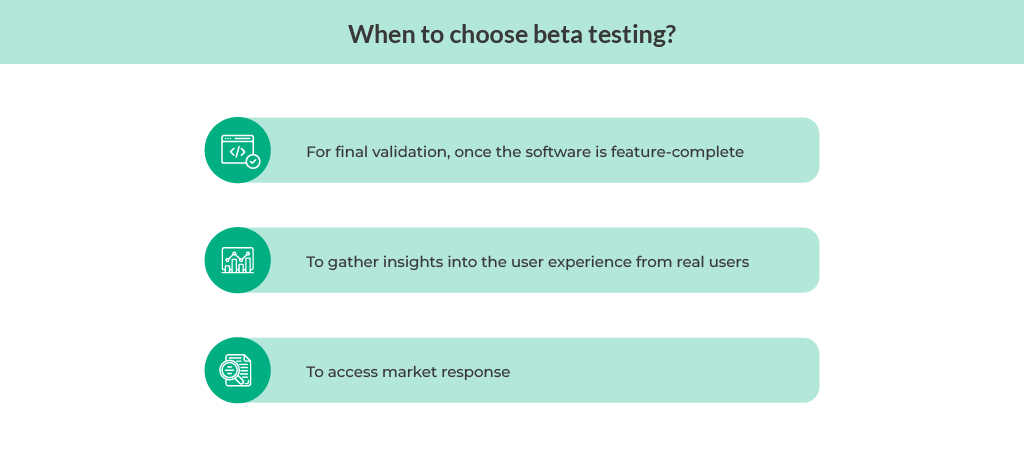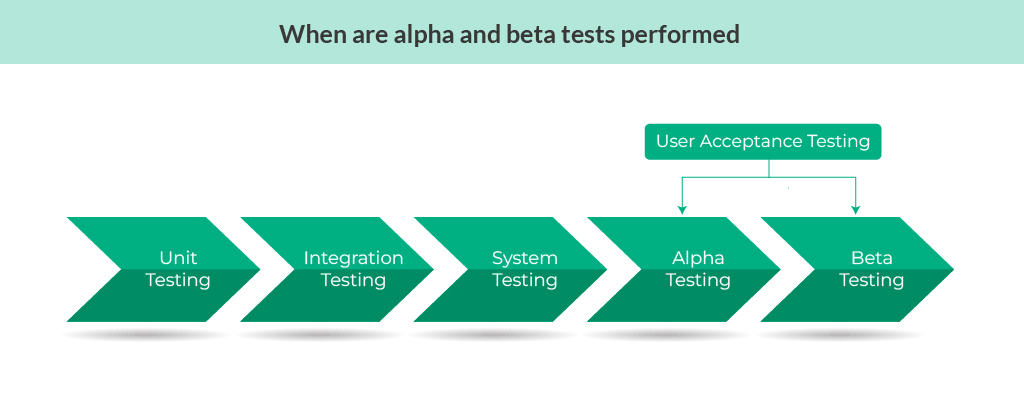A software product’s quality and reliability depend on the testing strategies deployed within the software development life cycle (SDLC). Throughout the SDLC, various types of software testing are conducted to detect defects, validate functionality, and improve user experience. Two such important testing techniques are alpha and beta testing (a type of user acceptance testing), which are performed before the product is launched in the market.
While in-house teams do alpha testing, beta testing is performed by external users. In this blog, we will discuss the differences between alpha and beta testing in detail.
What is Alpha Testing?
Alpha testing serves as the initial phase of testing conducted on a software product before it is released to the public. This stage is crucial for identifying and fixing issues within a controlled environment, ensuring that the software meets predefined quality standards before proceeding to broader testing or release.
H3: Characteristics of Alpha Testing
Alpha testing is characterized by:
- Testing is conducted in a controlled setting that simulates real world conditions
- Involves a small group of in-house selected individuals or teams who perform the testing
- Focuses on verifying that the software meets desired requirements and standards
- Identifies and resolves defects, errors, and inconsistencies found during testing
- A thorough examination of functionalities, performance, and reliability is done to uncover potential issues
- Feedback comes from internal testers, allowing for early detection and resolution of problems
Entry and Exit Criteria of Alpha Testing
You have to follow specific entry and exit criteria for alpha testing to ensure that the software undergoes thorough testing and evaluation before progressing further in the development cycle:
Entry Criteria
- Completion of Development: The software should be feature-complete with all functionalities implemented according to the defined specifications.
- Stable Build: A stable version of the software should be available for testing, free from major known defects that could hinder testing progress.
- Internal Approval: Internal stakeholders, such as project managers and developers, should review and approve the software’s readiness for alpha testing.
- Test Environment Setup: The testing environment, including necessary hardware and software configurations, should be prepared and available for conducting tests.
Exit Criteria
Here are the exit criteria for alpha testing:
- Bug Fixing: Critical bugs identified during alpha testing should be fixed and verified as resolved.
- Test Coverage: The software should undergo sufficient test coverage to ensure major functionalities are tested comprehensively. Here is a detailed guide on how to increase test coverage for you.
- Acceptance Criteria: The software should meet the predefined acceptance criteria, including performance benchmarks and quality standards.
- Documentation: Documentation related to test results, issues encountered, and fixes applied should be completed and reviewed.
- Management Approval: Approval from management or stakeholders confirming that the software is ready to proceed to the next phase of testing or release.
What is Beta Testing?
Beta testing is conducted to gather feedback from users and identify any remaining issues before the product’s commercial release. Unlike alpha testing, which is performed by internal teams (developers, QA staff, or a select group of internal users) in a controlled environment, beta testing is conducted by external real users in a real-world environment. This helps to ensure that the product works as expected in diverse scenarios and user conditions.
Characteristics of Beta Testing
Beta testing is characterized by:
- Testing takes place in environments that simulate the actual end-user environment, including various hardware setups and network configurations
- Focuses on gathering feedback from external users to evaluate how well the software meets user expectations and requirements
- Involves a broader user base outside of the development team or organization, including target audience members and selected users
- Conducted for a specific period to gather sufficient feedback and address identified issues within the testing timeline
- Emphasis on usability and user experience. Evaluates the software’s ease of use, intuitiveness, and overall user satisfaction, aiming to enhance these aspects before release
- Issues and feedback are addressed iteratively, with new builds or versions released to testers as improvements are made
Entry and Exit Criteria of Beta Testing
Beta testing follows specific criteria for entering and exiting the phase, ensuring that the software is adequately tested and validated before its commercial release.
Entry Criteria
- Completion of Alpha Testing: The software should have undergone alpha testing and addressed critical issues identified during that phase.
- Stable Beta Build: A stable version of the software, typically a release candidate (RC) or a version close to what will be released commercially, should be prepared for testing.
- Test Environment Setup: The beta testing environment, including access to the software and necessary documentation, should be prepared and accessible to external testers.
- Test Plan Approval: A detailed beta test plan outlining objectives, scope, methodologies, and success criteria should be reviewed and approved.
Exit Criteria
- Feedback Evaluation: Feedback from beta testers should be collected, analyzed, and categorized based on severity and impact on the software.
- Bug Fixing: Critical bugs and issues identified during beta testing should be addressed, and fixes verified as effective.
- Usability Validation: The software should meet usability and user experience goals based on feedback received from beta testers.
- Documentation: Comprehensive documentation of beta testing results, including issues encountered, resolved bugs, and user feedback summaries, should be completed.
- Management Approval: Approval from management or stakeholders confirming that the software is ready for commercial release based on beta testing results.
Alpha testing vs. Beta testing- Key differences
| Aspect | Alpha Testing | Beta Testing |
| Definition | A type of software testing conducted by developers and internal teams | Software testing conducted by actual users in a real environment |
| Purpose | To identify and fix bugs, improve usability, and ensure basic functionality | To get feedback from real users and identify issues not found in alpha testing |
| Participants | Internal employees, developers, and QA testers | Actual users or customers, usually external to the organization |
| Environment | Controlled environment, often within the development environment | Real world environment, similar to how it will be used post-release |
| Duration | Typically longer, spanning several weeks to months | Shorter duration, usually a few weeks to a month |
| Scope | Broad, covering all major functions and features of the product | More focused on specific features or overall user experience |
| Feedback Type | Technical feedback focused on bug reports and performance issues | User experience feedback, including usability, design, and satisfaction |
| Testing Stage | Conducted after unit and integration testing, before beta testing | Conducted after alpha testing, before the final release |
| Access | Limited access, often requiring non-disclosure agreements (NDAs) | Broader access, often through public announcements or invitations |
| Risk | Higher risk as the product is not yet stable | Lower risk as most critical issues are already addressed |
Alpha testing and Beta testing- Key similarities
Despite the distinct roles in the software development life cycle, alpha and beta testing also have some points in common. Here are the key similarities:
- Alpha and beta testing are designed to enhance the quality of the software by detecting and addressing issues and bugs throughout the testing phases.
- Both types of testing involve discovering and documenting bugs, defects, and inconsistencies in the software to ensure its functionality and reliability.
- Feedback from testers, whether internal (alpha testing) or external (beta testing), plays a crucial role in identifying usability issues, understanding user experience, and validating software requirements.
- Both alpha and beta testing involve iterative cycles of testing, feedback, and refinement. This iterative approach helps improve the software progressively and address issues as they are discovered.
- Alpha and beta testing are categorized under User Acceptance Testing (UAT), where the software is evaluated against user requirements to ensure it meets intended use and functionality expectations.
Alpha testing vs Beta testing- Which one to choose?
Choosing between alpha and beta testing depends on the stage of development and your specific testing needs. Alpha testing is ideal for early development, controlled environments, and initial validation. Beta testing, on the other hand, is suitable for the pre-release stage, gathering user experience insights and assessing market readiness.
When to Choose Alpha Testing?

Early Development Stage: Choose alpha testing during the early stages of development when you need to identify and fix bugs before proceeding to broader testing phases. This helps in stabilizing the core functionality of the software.
Controlled Environment: If you require testing in a controlled environment where variables can be managed, alpha testing is ideal. This ensures a systematic approach to identifying and resolving issues without external interference.
Initial Validation: Opt for alpha testing to perform initial validation of the software’s functionality, usability, and performance. This internal assessment helps in ensuring that the software meets the basic quality standards before external evaluation.
When to Choose Beta Testing?

Pre-Release Stage: Beta testing is best suited for the pre-release stage when the software is feature-complete and needs final validation. This phase helps in identifying any remaining issues that may not have been detected during alpha testing.
User Experience Insights: Choose beta testing to gather insights into the user experience from real users. This feedback is significant for understanding how the software performs in real-world conditions and how users interact with it.
Market Readiness: Beta testing is essential for assessing market readiness. It provides a platform for testing the software’s acceptance and performance in the target market.
Conclusion
Alpha testing, conducted by internal team members in a controlled environment, helps detect bugs early, ensuring initial validation and improving software quality. On the other hand, beta testing, carried out by external users in real-world conditions, provides valuable user feedback, assesses market readiness, and finalizes the user experience.
At QA Touch, we understand the critical role of thorough testing in delivering high-quality software. Our comprehensive test management software helps streamline alpha and beta testing. With features like screen and audio recording for issue reporting, comprehensive issue-tracking capabilities and a user-friendly interface, you can improve your testing process and significantly reduce the time to launch and ensure a successful release.
Ready to enhance your software testing process?
Experience the power of AI testing with QA Touch. Start your 14-day free trial and start using instantly!








